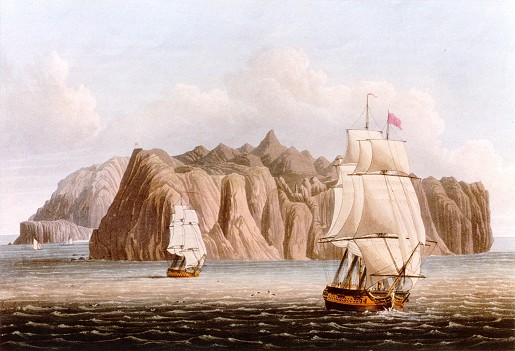
View No. I. is taken from the north-west side of the Island, about eight miles from the land. At this distance it appears entirely without trees, shrubs, or even verdure, and is like a huge castle, its heights towering to the clouds, and the stupendous cliffs of the fore-ground overhanging the ocean.
![]()
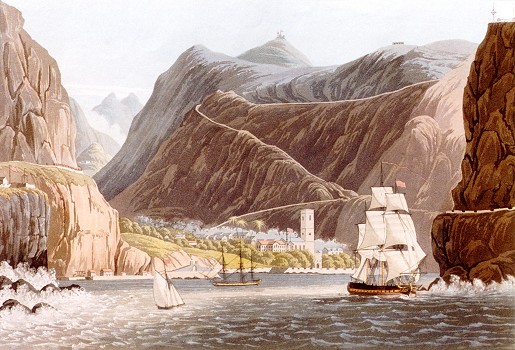
View No. II. was taken on the north-east side of the Island, in the Roads, where the shore is very bold and majestic. Before ships enter, a boat is dispatched to give notice to the Governor, reporting their nation and business. During this time every ship must lie-to until a signal is made to advance, and cannot pass Munden's Battery before leave be granted to proceed. On anchoring, ships salute the fort, and the battery on Ladder Hill returns it, when the reverberation of the echo from the surrounding mountains is truly grand. The distant hill, with a fort on the summit, called High Knoll, is about 1900 feet from the level of the sea. The principal landing is immediately under Munden's Battery, a dark huge rock on the left, under Rupert's Hill. The road leading from the Pier to the Government House is over a draw-bridge, on the right of which is a battery of heavy guns. At the extremity of an avenue of trees is a strong gateway, which leads to the Parade in St. James's Valley. Near the opening between the two mountains, Ladder Hill on the right, and Rupert's Hill on the left, is a small knoll, or conical hill, at the foot of which is a house called the Briars, marked in this View, though not seen from the Roads ; this situation is the more interesting, as it is said to be the place intended for the residence of Buonaparte.
![]()
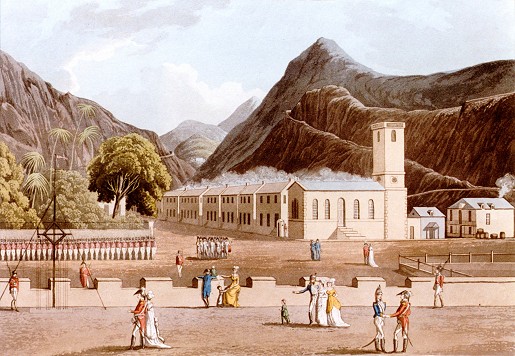
View No. III. represents St. James's Town, situated in the valley between Ladder Hill and Rupert's Hill. This View is taken from the Castle Terrace, the grand promenade for company during the parades. Near the centre is the Church, on the right of which is the Theatre, and also the Tavern ; and on the left, a row of houses forming the principal street. The roofs are, in general, of boards, and covered with puzzolana, a kind of volcanic cement. At the head of the valley is shown the Briars, the intended residence of Buonaparte, as stated in No. II. The Main-Guard, Storehouses, and Barracks are opposite the Church, and could not be introduced in this View consistently with the rules of perspective. At the upper end of the street is the Freemason's Lodge and Hospital, where the road branches off, on the left, to Munden's Fort, Rupert's Valley, and LongWood, the residence of the Lieutenant-Governor, near to which is the principal Alarm-House, 1960 feet high, on the south side of the Island. The road on the right of the Lodge winds up Ladder Hill to Friar's Valley and the base of High Knoll, and over a dreary and barren country, till Plantation-House presents itself, together with a beautiful landscape of green pastures, woody heights, and neat dwellings, forming a most picturesque scene, as in No. IV.
![]()
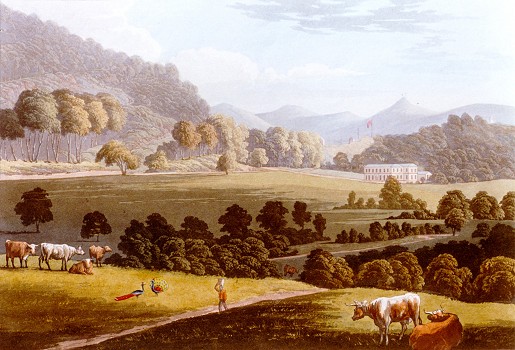
View No. IV. is Plantation-House, a large modern-built edifice, the country residence of the Governor, situated in the most fertile and beautiful part of the Island. It is approached through a handsome iron gate, on each side of which is a neat lodge. Adjoining is a telegraph, which communicates with all the forts and out-posts. The grounds are laid out with great taste ; a variety of oriental plants and shrubs grow intermixed with those of the more northern regions : the magnolia, mimosa, myrtles thirty feet high, bamboo, gum tree, and cabbage tree, with the laurel, yew, cypress, fir, and oak ; and also aloes in successive blossom. Plantation-House is three miles and a half from the Castle in St. James's Valley.
![]()

View No. V. Entering Friar's Valley from the east, the central object is an immense pile of rocks rising perpendicularly eight hundred feet above the level of the sea. On the right is seen a fine opening to the Atlantic Ocean ; and on the left, another, in the centre of which appears a very curious and interesting object composed of five rocks, firmly cemented by Nature, affording a fanciful resemblance of a Friar in the habit of his Order, from whence the valley takes its name. Planters' houses, verdant and naked mountains, diversify the scene, and render the whole extremely picturesque and sublime.
![]()
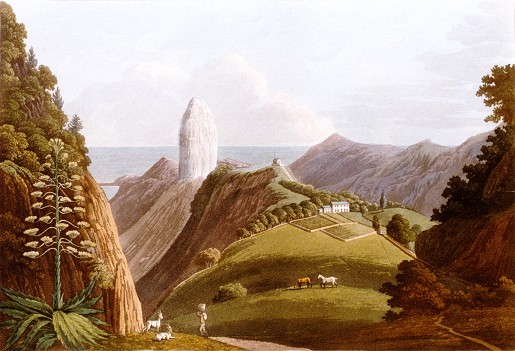
View No. VI. is Fairy Land, on the south side of the Island, in the district of Sandy Bay. It presents a singularly romantic appearance. Here stands an erect column, (called Lot,) composed of a hard greyish rock, situated upon a hill of vitrified matter, so steep and slippery as to be wholly inaccessible. In this View, which is taken from an eminence on the north-west side, hills rise above hills ; the left, clothed with wood to the summit, displays an extraordinary contrast to the wild nakedness of the other side ; the downward View consists of a variety of ridges, eminences, and ravines, descending into the sea. The beauty of one part, the grandeur of another, and the horror of a third, cannot fail to astonish every observer. The Island, from this situation, has certainly the appearance of being forced up by subterraneous fire : the abrupt ridges and chasms into which it is split seeming strongly to indicate a volcanic origin.
![]()
Page maintained by Barry Weaver